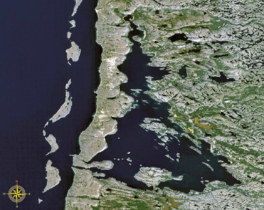Lake Tasiujaq facts for kids
Quick facts for kids Lake Tasiujaq |
|
|---|---|
| Richmond Gulf / Lac Guillaume-Delisle | |

Satellite view
|
|
| Location | Hudson Bay, Nunavik, Quebec |
| Coordinates | 56°14′58″N 76°17′39″W / 56.24944°N 76.29417°W |
| Primary inflows | Clearwater River |
| Primary outflows | Le Goulet |
| Basin countries | Canada |
| Max. length | 61 km (38 mi) |
| Max. width | 22 km (14 mi) |
| Surface area | 712 km2 (275 sq mi) |
| Settlements | Umiujaq |
Lake Tasiujaq is a large, triangle-shaped bay in Quebec, Canada. It is located on the eastern side of Hudson Bay. Its name in the Inuit language, Tasiujaq, means "which resembles a lake."
This bay was once known as Richmond Gulf in English and Lac Guillaume-Delisle in French. In 2008, local leaders asked to change its name to Lac Tasiujaq. This new name became official in 2016.
The area around Lake Tasiujaq, including the nearby Clearwater Lakes, is now part of Tursujuq National Park. This park was officially created on July 18, 2013.
On the southern shore of the lake, you can find the remains of an old trading post. This post was called Fort Richmond and was run by the Hudson's Bay Company. It operated from 1750 to 1759 and again from 1921 to 1927.
Contents
Geography of Lake Tasiujaq
The shape of Lake Tasiujaq's land comes from two geological faults. These are cracks in the Earth's crust that run along the coast. These faults have created the tall cliffs that you see on the western side of the lake.
The western shore has steep, rocky walls made of sedimentary rock. These walls rise sharply from the slightly salty water. This unusual coastline is part of the Hudsonian Cuestas. These are the highest system of cuestas (hills with a gentle slope on one side and a steep slope on the other) in Quebec.
There is only one narrow opening in these rocky walls. It's at the far southwest end and is called "Le Goulet" (which means "narrows" or "bottleneck" in French). This passage is about 5 kilometers (3 miles) long and 300 to 600 meters (980 to 2,000 feet) wide. It is surrounded by cliffs that are 200 meters (660 feet) high. A large amount of water flows through Le Goulet as the tides go in and out. This creates water level changes of about 0.5 meters (1.6 feet). Because of this strong flow, this passage does not freeze in the winter.
The eastern shore of the lake slopes more gently. It is mostly made of Canadian Shield rock, with basalt rock covering many areas. Several large rivers flow into Richmond Gulf, creating fast rapids or tall falls. One example is the Clearwater River.
Point Pamiallualuk is a thin piece of rock that sticks out about 2 kilometers (1.2 miles) into Hudson Bay. It is just north of Le Goulet. Here, the north-flowing tidal current of Hudson Bay crashes into a weaker counter-current. This creates a lot of choppy water, which gets even stronger with high winds.
History of the Lake's Name
In 1743, the Hudson's Bay Company (HBC) asked its trading post at Fort Albany, Ontario, to explore the eastern coast of Hudson Bay. This area was not often visited because it was barren and did not have many furs.
In 1744, Thomas Mitchell, a captain for the HBC, sailed into the lake. He named it "Sir Atwell's Lake," likely after Sir Atwell Lake, who was a Deputy Governor of the HBC. Captain Mitchell also wrote down the Cree name for this place, "Winipeq," that same year. A map from 1749 by William Coats showed the lake with the Cree name "Artiwinipeck" and the English name "Sir Atwell's Lake."
Over time, this body of water was given several other names. These included "Winipeke Bay," "Hazard Gulf," "Gulf of Richmond," and "Richmond Bay." Finally, in 1905, the Geography Commission of Canada officially accepted the name Richmond Gulf. It is not clear why this name was chosen. It might have been named after the Duke of Richmond or after Thomas Mitchell's small ship.
In 1962, the Quebec Government decided to give French names to places in northern Quebec. They changed the name to "Lac Guillaume-Delisle." This was to honor Guillaume Delisle (1675-1726), a famous mapmaker and the First Royal Geographer of France.
In 1749, the HBC decided to build a new trading post on the east side of Hudson Bay. Trade in this area had been done by small ships from Fort Albany. Most of this trade happened in the forested lands south of Richmond Gulf. The reason for building the new post is not fully known. It might have been because of rumors that other traders, not from the HBC, were planning to enter the Bay.
In 1750, Captain Coates and John Potts built Fort Richmond. It was located on an island called Factory Island, off the southern shore of the inlet. Since the area did not produce many furs, the post was closed in 1759.
Animals and Plants of Lake Tasiujaq
Many rivers flow into Lake Tasiujaq, making its water slightly salty. This creates a good home for different types of fish, like brook trout and whitefish. Larger animals like beluga whales and seals also live here.
Many species of birds use the lake for summer shelter and to build their nests. These include common loons, eider ducks, and peregrine falcons.
Around the lake, in the tundra landscape, you can find scattered black spruce trees and larch trees. The area has more than 415 different types of vascular plants. About 65% of these (271 species) can be found on the group of islands within the Gulf, known as the Hybrid Archipelago.
See also
 In Spanish: Lago Guillaume-Delisle para niños
In Spanish: Lago Guillaume-Delisle para niños


